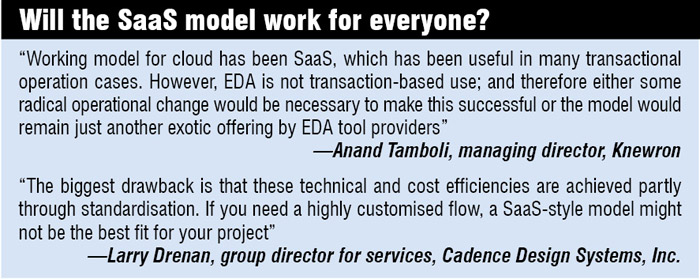Is it really going to be cheaper?
Overall, there will be almost zero capital expenses (CAPEX) as all of the cost would be under operational expenses (OPEX).
“The biggest drawback is that these technical and cost efficiencies are achieved partly through standardisation. If you need a highly customised flow, a SaaS-style model might not be the best fit for your project,” explains Drenan.
While EDA in the cloud may reduce licensing cost (as it changes from one-time to subscription-/usage-based), it would add up significantly into the total cost of ownership.
“Now the engineering design process is not as straightforward or simple as some service transactions where everything is set and defined. This means the user has to be in front of design for ‘N’ number of hours before he could take the next step. If EDA providers offer pay-per-use (hour-/minute-based costing), this will be huge overload on the designers and design organisations that could eventually restrict people from using EDA in the cloud,” adds Anand.
What does EDA in the cloud do best?
Designing from scratch may not go well with EDA in the cloud. “These solutions (EDA in the cloud) are more suitable where creativity and design contribution is not significant. This means services such as data conversion from one format to another or some editing or minor changes in existing designs,” says Anand.

“Other services which could benefit from this type of service are design-rule compliance verification for various certifications (CE, FCC, etc) and original equipment manufacturing where EDA outputs are used for final production/delivery (and thus EDA itself does not consume significant time),” he adds.
Startups. Startups could find cloud-based EDA solutions useful as they would not normally be able to afford the one-time licensing fees associated with conventional EDA tools.
“One of the ideal solutions for startups is hosted design solution. These SaaS solutions combine production-proven technology, methodologies, services, collaboration and IT infrastructure. Outsourcing the elements of a production-grade design environment that are non-differentiating yet critical, can address certain customer needs for reduced cost and risk, and is perfect for startups where budget considerations are critical,” adds Jaswinder Ahuja, corporate vice president and managing director, Cadence Design Systems.
Cloud-based EDA could be a godsend for those electronics industry startups which want to work with genuine EDA tools but are unable to afford their huge price tag. In fact, this is the reason for the widespread piracy of EDA tools. (Refer ‘How EDA Tool Providers Are Supporting Startups, And Fighting Piracy,’ published in Sept. 2012 issue of EFY magazine.)
How long before EDA in the cloud becomes mainstream? Everybody agrees that EDA in the cloud is here to stay, but for several years there has been a significant confusion on when it would become mainstream. Even in 2011, when the Design Automation Conference (DAC) Panel discussed EDA in the cloud, the discussion had answers pointing to adoption within three years, while others said that eight is a more realistic number. Judging by the number of new startups focused on cloud-based EDA solutions coming up, I would say that the change is almost here!
The author is a tech correspondent at EFY Bengaluru






